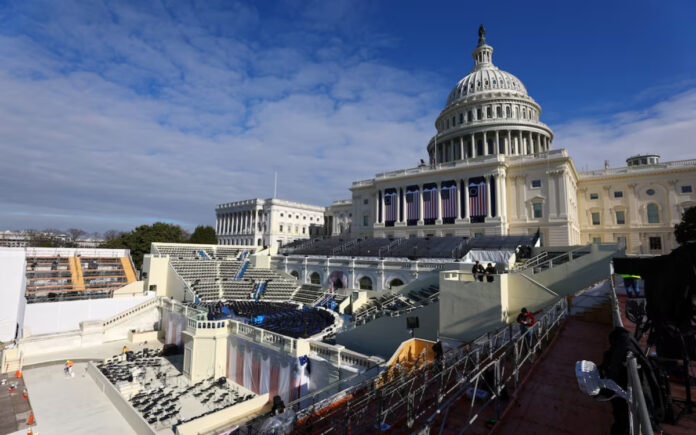Washington: President-elect Donald Trump’s inauguration will take place indoors at the U.S. Capitol on Monday, marking the first time in 40 years that the presidential swearing-in ceremony has been moved indoors due to severe cold. The decision comes as an Arctic blast sweeps across the country, posing a significant risk to the health and safety of those attending.
“There is an Arctic blast sweeping the country. I don’t want to see people hurt, or injured, in any way,” Trump said in a post on his Truth Social platform on Friday. “Therefore, I have ordered the Inauguration Address, in addition to prayers and other speeches, to be delivered in the United States Capitol Rotunda.”
The last time an inauguration was moved indoors due to extreme cold was in 1985 for President Ronald Reagan’s second swearing-in, when the wind chill fell to between minus 10 and minus 20 degrees Fahrenheit (minus 23 to minus 29 degrees Celsius). On Monday, the forecasted temperature for Washington at the time of Trump’s swearing-in is expected to be around 19°F (-7°C), with the wind chill making it feel even colder.
Trump announced that supporters can view the ceremony on large screens inside the Capital One Arena, a venue typically used for basketball and hockey that can hold 20,000 spectators. The presidential parade, which was originally planned to march down Pennsylvania Avenue, will now be held at the arena. While the logistics of hosting a parade inside the venue remain unclear, Trump intends to join the crowd there after being sworn in.
No Crowd-Size Comparisons This Time
The move indoors will prevent any comparisons of Trump’s crowd size to previous inaugurations. Following his first swearing-in in 2017, Trump expressed frustration with media reports suggesting that his crowd on the National Mall was much smaller than the one that attended Barack Obama’s first inauguration in 2009.
This change of venue significantly reduces the number of people who can attend the ceremony in person. Over 220,000 ticketed guests who had planned to view the event from the U.S. Capitol grounds will now be unable to attend. Additionally, 250,000 unticketed members of the public were expected to watch from the National Mall, according to a permit issued by the National Park Service. However, only a small fraction of this number will be able to fit into the Capital One Arena.
Tammy Matte, a school secretary from Laurel, Mississippi, had tickets to attend but canceled her trip upon learning that the inauguration would be moved indoors. “We don’t feel it’s worth it not to see the ceremony in person,” said Matte, 58, noting that the nearly 1,000-mile car ride to Washington was no longer justified.
It remains unclear whether crowds will still be permitted to gather on the National Mall to watch the ceremony on large video screens already set up in the area.
Also Read | $25 Million Deal: Dawn Staley Sets New Benchmark in Women’s Basketball Coaching
Rally and Security Measures
Trump is scheduled to hold a rally with supporters inside the Capital One Arena on Sunday, the day before his inauguration. Meanwhile, law enforcement agencies, including the U.S. Secret Service, are working with Trump’s inaugural committee and congressional officials to adapt security plans due to the anticipated severe weather conditions.
Also Read | Xi Emphasizes China-Vietnam’s Shared Future of Strategic Importance
Winter Chill as an Inaugural Tradition
Cold weather has historically played a role in several U.S. inaugurations. For Obama’s first inauguration in 2009, temperatures were also frigid, reaching only about 29°F (-1.5°C). Notably, President William Henry Harrison, during his inauguration in 1841, gave the longest inaugural address in wet, cold conditions without a coat or hat. He contracted pneumonia shortly afterward and died a month into his presidency, making it the shortest in American history.
During Ulysses S. Grant’s second swearing-in in 1873, cadets and midshipmen collapsed in the frigid weather, and gusting winds made Grant’s speech inaudible to many nearby. The low temperature of 4°F (-15°C) on that day remains the coldest March day on record in Washington.



